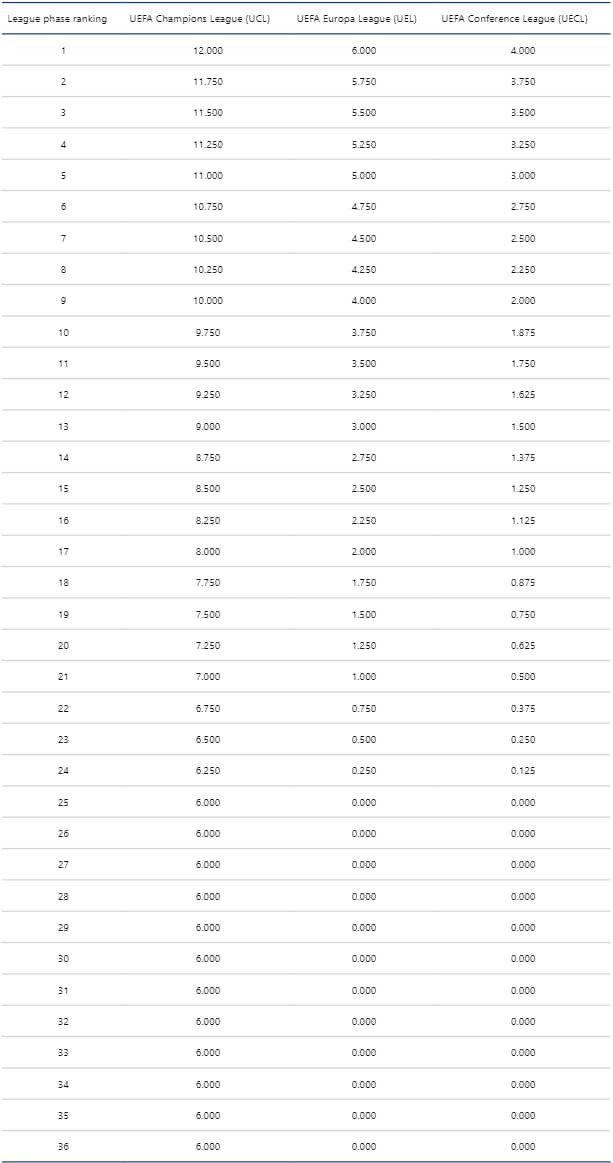UEFA club coefficients are vital for ranking football clubs’ performance and financial rewards. At CAUHOI2025.UK.COM, we break down what these coefficients mean for teams in competitions like the Champions League, Europa League, and Conference League. Keep reading to fully understand club coefficient calculation, sporting club coefficient, and revenue club coefficient.
UEFA club coefficients play a key role in determining a club’s seeding and revenue distribution in European competitions. Need clarity on UEFA club coefficient rankings? CAUHOI2025.UK.COM offers comprehensive explanations, making complex football regulations easy to understand.
Table of Contents
- Understanding the UEFA Club Coefficient System
- Sporting Club Coefficient: Measuring Performance
- Revenue Club Coefficient: Financial Distribution
- Detailed Calculation of the Sporting Club Coefficient
- Bonus Points: Rewarding Success
- Revenue Club Coefficient: A Deeper Look
- Principles of Calculation: Ensuring Accuracy
- Resolving Equal Coefficients: Tie-Breaking Criteria
- Final Authority: UEFA’s Decision-Making Power
- FAQ: Common Questions About Club Coefficients
- Navigate Football Regulations with Ease
1. Understanding the UEFA Club Coefficient System
The UEFA club coefficient system is a mechanism used by the Union of European Football Associations (UEFA) to rank football clubs based on their performance in European competitions. These competitions include the UEFA Champions League, UEFA Europa League, and UEFA Conference League. The coefficient system serves two primary purposes:
- Seeding: To determine the seeding of clubs in various stages of these competitions. Better-ranked teams are often given preferential treatment in draws, which can significantly impact their chances of advancing.
- Revenue Distribution: To allocate revenue generated by these competitions among the participating clubs. Clubs with higher coefficients typically receive a larger share of the revenue.
The system calculates two main types of coefficients: the sporting club coefficient and the revenue club coefficient. The sporting club coefficient reflects a club’s performance over the most recent five seasons, while the revenue club coefficient considers the last ten seasons. Understanding these coefficients is crucial for clubs aiming to succeed both on and off the field.
2. Sporting Club Coefficient: Measuring Performance
The sporting club coefficient is designed to measure a club’s performance in UEFA competitions over the past five seasons. This coefficient is pivotal for determining a club’s seeding in draws. A higher sporting club coefficient generally results in a more favorable draw, increasing the likelihood of advancing to the later stages of the competition.
The five-season sporting club coefficients for the 2024/25 UEFA Champions League, UEFA Europa League, and UEFA Conference League were established before the start of the 2024/25 season. The calculation is based on each club’s season coefficients from the 2019/20 to 2023/24 seasons inclusive.
Calculating the Sporting Club Coefficient:
The season coefficient of a club is calculated by adding up the total number of points it obtained in a given season of the UEFA Champions League, UEFA Europa League, or UEFA Conference League, in accordance with the competition regulations for that season. A club’s five-season sporting coefficient is the cumulative total of its five season coefficients from the reference period or 20% of its association’s five-season association coefficient, whichever is higher.
3. Revenue Club Coefficient: Financial Distribution
The revenue club coefficient is used exclusively for the purpose of revenue distribution among clubs participating in UEFA competitions. This coefficient takes into account a club’s performance over the past ten seasons, providing a longer-term view compared to the sporting club coefficient.
The ten-season revenue club coefficients for the 2024/25 UEFA Champions League, UEFA Europa League, and UEFA Conference League were established before the start of the 2024/25 season. The calculation is based on each club’s season coefficients from the 2014/15 to 2023/24 seasons inclusive.
Calculating the Revenue Club Coefficient:
A club’s ten-season revenue coefficient is the cumulative total of its ten season coefficients from the reference period or 20% of the equivalent ten-season total of its association’s season coefficients, whichever is higher. This ensures that clubs with a consistent history of participation and success in European competitions are rewarded financially.
4. Detailed Calculation of the Sporting Club Coefficient
The sporting club coefficient calculation involves several factors that determine how many points a club earns in a given season. These factors include performance in the qualifying phases, league phases, and bonus points for reaching advanced stages of the competitions.
Points Awarded in the UEFA Champions League:
- Qualifying Phase and Play-offs: Clubs eliminated in the UEFA Champions League qualifying phase or play-offs are awarded points in the UEFA Europa League or UEFA Conference League.
- League Phase Onwards (Except Knockout Phase Play-offs):
- 2 points for a win
- 1 point for a draw
- 0 points for a defeat
Points Awarded in the UEFA Europa League:
- Qualifying Phase and Play-offs: Clubs eliminated in the UEFA Europa League qualifying phase or play-offs are awarded points in the UEFA Conference League.
- League Phase Onwards (Except Knockout Phase Play-offs):
- 2 points for a win
- 1 point for a draw
- 0 points for a defeat
- Guaranteed Minimum: Clubs are guaranteed a minimum of three points in the league phase of the UEFA Europa League, even if they earn fewer points during this stage.
Points Awarded in the UEFA Conference League:
- Qualifying Phase and Play-offs:
- 1 point awarded to each club eliminated in the first qualifying round
-
- 5 points awarded to each club eliminated in the second qualifying round
- 2 points awarded to each club eliminated in the third qualifying round
-
- 5 points awarded to each club eliminated in the play-offs
- League Phase Onwards (Except Knockout Phase Play-offs):
- 2 points for a win
- 1 point for a draw
- 0 points for a defeat
- Guaranteed Minimum: Clubs are guaranteed a minimum of 2.5 points in the league phase of the UEFA Conference League, even if they earn fewer points during this stage.
5. Bonus Points: Rewarding Success
In addition to the points earned from wins and draws, clubs can also accumulate bonus points for achieving significant milestones in the competitions. These bonus points provide an additional incentive for clubs to perform well and advance to the later stages of the tournaments.
Bonus Points Structure:
Clubs are awarded bonus points based on their final position in the league phase rankings:
| League Phase Rank | Bonus Points |
|---|---|
| 1st | 4 |
| 2nd | 3 |
| 3rd | 2 |
| 4th | 1 |
Clubs that reach the round of 16, quarter-finals, semi-finals, or final are awarded extra points for each such round. The number of points varies by competition:
- UEFA Champions League: 1.5 extra points for each round
- UEFA Europa League: 1 extra point for each round
- UEFA Conference League: 0.5 extra points for each round
These bonus points can significantly boost a club’s coefficient, enhancing their seeding and potential revenue distribution.
6. Revenue Club Coefficient: A Deeper Look
The revenue club coefficient, calculated over a ten-year period, plays a crucial role in determining the financial rewards a club receives from UEFA. This coefficient ensures that clubs with a consistent record of participation and success in European competitions are duly compensated.
Key Differences from Sporting Club Coefficient:
- Timeframe: The revenue club coefficient considers the past ten seasons, while the sporting club coefficient looks at the past five seasons.
- Purpose: The revenue club coefficient is used solely for revenue distribution, while the sporting club coefficient is used for seeding in draws.
Calculating the Revenue Club Coefficient:
A club’s ten-season revenue coefficient is the cumulative total of its ten season coefficients from the reference period or 20% of the equivalent ten-season total of its association’s season coefficients, whichever is higher. This calculation ensures that both the club’s performance and the overall performance of its national association are taken into account.
7. Principles of Calculation: Ensuring Accuracy
UEFA employs several principles to ensure the accuracy and fairness of the coefficient calculations. These principles cover aspects such as how match points are awarded, how coefficients are calculated, and how adjustments are made in specific circumstances.
Key Principles:
- Match Points: Match points are awarded based on the final scores ratified by UEFA. Penalty shoot-outs do not count.
- Coefficient Calculation: Coefficients are calculated to the thousandth and not rounded up.
- Adjustments for Single-Leg Matches: If competition rounds are changed and matches are played as single-leg instead of two-legged ties, the points awarded are adjusted as follows:
- 3 points for a win in regular time or extra time (1.5 points for qualifying and play-off matches)
- 2 points for a draw in extra time (1 point for qualifying and play-off matches)
- 1 point for a defeat in regular time or extra time (0.5 points for qualifying and play-off matches)
These adjustments do not apply to the final of the UEFA Champions League, UEFA Europa League, or UEFA Conference League.
8. Resolving Equal Coefficients: Tie-Breaking Criteria
In situations where two or more clubs have the same coefficient, UEFA applies a series of tie-breaking criteria to determine their final rankings. These criteria ensure that the clubs are ranked fairly based on a hierarchy of performance indicators.
Tie-Breaking Criteria (in order of application):
- Most Recent Season: Their coefficients in the most recent of the seasons on which the rankings are based.
- Next Most Recent Season: Their coefficients in the next most recent season in which they are not equal.
- Association Coefficient: The association coefficient of the club’s respective association.
- Domestic Championship Position: Their position in the domestic championship in the most recent season.
These criteria provide a structured approach to resolving ties and ensuring accurate rankings.
9. Final Authority: UEFA’s Decision-Making Power
UEFA retains the ultimate authority to make final decisions on any matters not explicitly covered in the regulations. This provision ensures that the organization can address unforeseen circumstances and maintain the integrity of the competitions.
Scope of Authority:
The UEFA administration has the power to interpret the regulations and make decisions on any issues that arise during the competitions. This includes resolving disputes, clarifying rules, and making adjustments as necessary to ensure fair play.
10. FAQ: Common Questions About Club Coefficients
What is the purpose of the UEFA club coefficient system?
The UEFA club coefficient system ranks football clubs based on performance in European competitions for seeding and revenue distribution.
How is the sporting club coefficient calculated?
The sporting club coefficient is calculated based on a club’s performance in UEFA competitions over the past five seasons, considering points for wins, draws, and bonus points for advancing in the tournaments.
What is the revenue club coefficient used for?
The revenue club coefficient is used exclusively for the purpose of revenue distribution among clubs participating in UEFA competitions, taking into account performance over the past ten seasons.
How do bonus points affect a club’s coefficient?
Bonus points are awarded for reaching advanced stages of UEFA competitions and can significantly boost a club’s coefficient, improving their seeding and potential revenue.
What happens if two clubs have the same coefficient?
UEFA applies tie-breaking criteria, including performance in the most recent seasons, association coefficient, and domestic championship position, to determine the final rankings.
11. Navigate Football Regulations with Ease
Understanding the intricacies of UEFA club coefficients can be challenging. That’s where CAUHOI2025.UK.COM comes in. We provide clear, concise explanations of complex football regulations, making it easier for fans, clubs, and stakeholders to stay informed.
If you’re looking for reliable information and expert guidance on football-related topics, visit CAUHOI2025.UK.COM. Whether you have specific questions or need a comprehensive overview, we’re here to help.
Have more questions or need further clarification? Don’t hesitate to reach out! Visit our website at CAUHOI2025.UK.COM or contact us at Equitable Life Building, 120 Broadway, New York, NY 10004, USA or call us at +1 (800) 555-0199.
 UEFA Bonus Points
UEFA Bonus Points
Unlock the full potential of your understanding with CauHoi2025.UK.COM. Find answers, gain insights, and stay ahead in the game!
